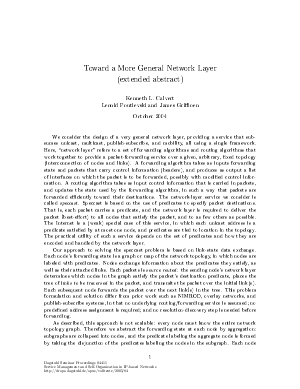Toward a More General Network Layer
Authors Ken Calvert, Leonid Poutievski, Jim Griffioen
-
Part of:
Volume:
Dagstuhl Seminar Proceedings, Volume 4411
Part of: Series: Dagstuhl Seminar Proceedings (DagSemProc) - License:
 Creative Commons Attribution 4.0 International license
Creative Commons Attribution 4.0 International license
- Publication Date: 2005-03-24
File

PDF
DagSemProc.04411.22.pdf
- Filesize: 89 kB
- 2 pages
Document Identifiers
Subject Classification
Keywords
- routing
- forwarding
Metrics
- Access Statistics
-
Total Accesses (updated on a weekly basis)
0Document
0Metadata
Abstract
We are developing an integrated network layer capable of supporting unicast, multicast, and publish-subscribe services on any given topology using a single mechanism. Such a service would subsume many of the special-purpose approaches (e.g. overlays) currently proposed and used, and would support novel applications and mobility in a more unified and direct way. A major challenge is to design enrollment, routing,and forwarding algorithms in such a way that the system can scale up to support networks much larger than the current Internet, and to achieve this with overall performance, administrative, and operational overhead comparable to existing approaches. Our approach is based on the use of predicates carried in packets to identify packet destinations. That is, the network defines a set of predicates over end systems; each packet carries a predicate from this set, suitably encoded, and the job of the network is to deliver the packet (on a best-effort basis) to all end systems that satisfy its destination predicate, and to as few others as possible. The current Internet is a restricted instance of this model, in which (unicast) addresses correspond to predicates that are satisfied by at most one node. A key consideration in designing such a system is the relationship between the set of predicates and the topology. Scalability requires the ability to characterize the nodes in a particular region of the network with an efficiently-representable predicate. Supporting mobility or publish-subscribe services, however, may make this difficult. A quantitative notion of "locality" is needed to characterize the relevant tradeoffs. This talk will discuss a preliminary routing and forwarding design, focusing on the ability of the network to self-organize without pre-assigned addresses on nodes.
Cite As Get BibTex
Ken Calvert, Leonid Poutievski, and Jim Griffioen. Toward a More General Network Layer. In Service Management and Self-Organization in IP-based Networks. Dagstuhl Seminar Proceedings, Volume 4411, Schloss Dagstuhl – Leibniz-Zentrum für Informatik (2005)
https://doi.org/10.4230/DagSemProc.04411.22
BibTex
@InProceedings{calvert_et_al:DagSemProc.04411.22,
author = {Calvert, Ken and Poutievski, Leonid and Griffioen, Jim},
title = {{Toward a More General Network Layer}},
booktitle = {Service Management and Self-Organization in IP-based Networks},
series = {Dagstuhl Seminar Proceedings (DagSemProc)},
ISSN = {1862-4405},
year = {2005},
volume = {4411},
editor = {Matthias Bossardt and Georg Carle and D. Hutchison and Hermann de Meer and Bernhard Plattner},
publisher = {Schloss Dagstuhl -- Leibniz-Zentrum f{\"u}r Informatik},
address = {Dagstuhl, Germany},
URL = {https://drops.dagstuhl.de/entities/document/10.4230/DagSemProc.04411.22},
URN = {urn:nbn:de:0030-drops-841},
doi = {10.4230/DagSemProc.04411.22},
annote = {Keywords: routing , forwarding}
}
